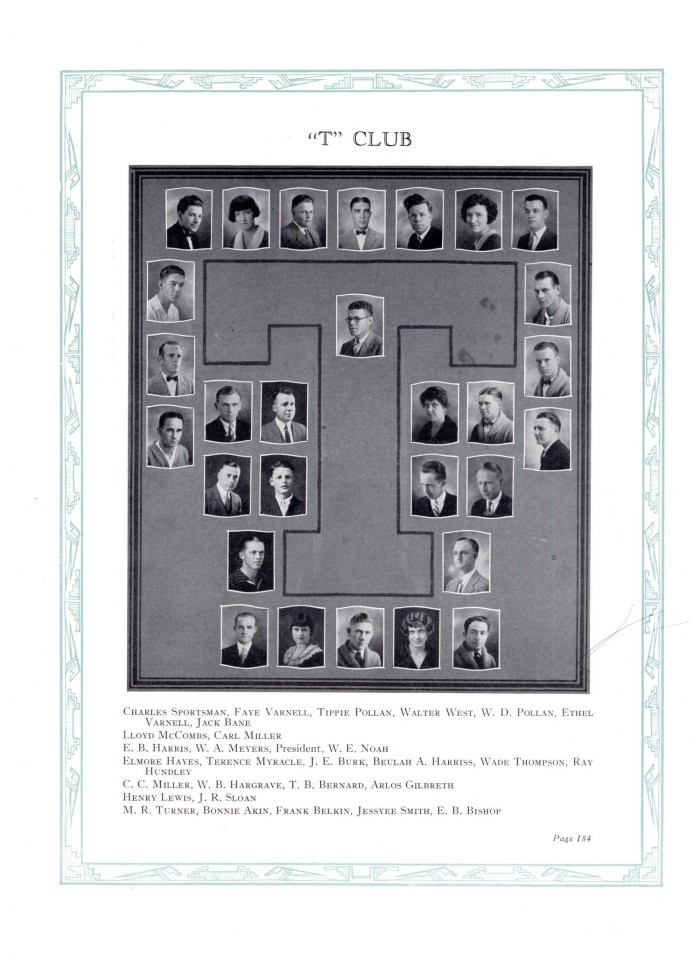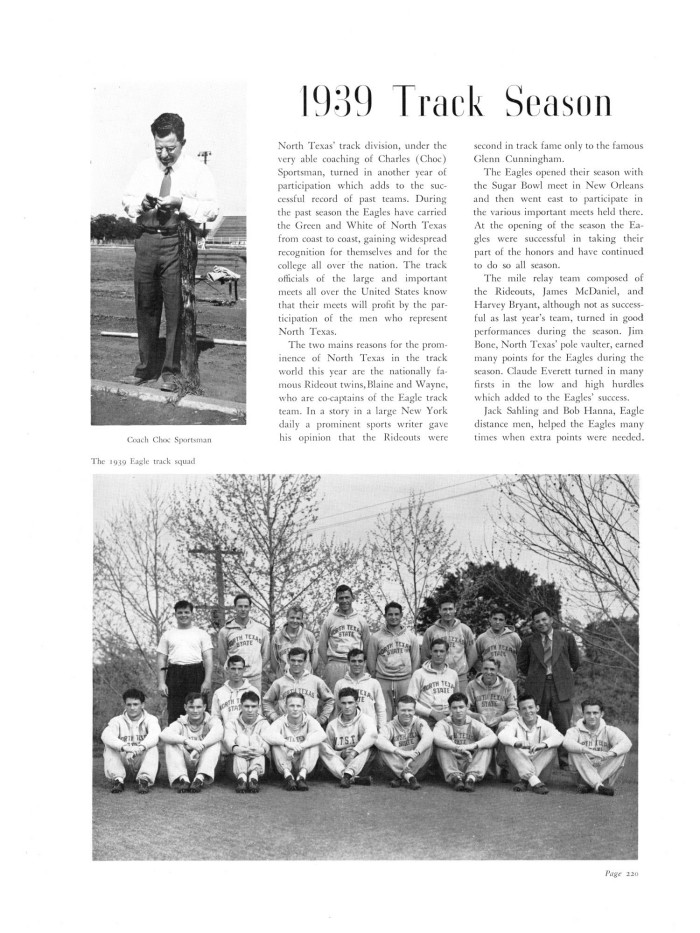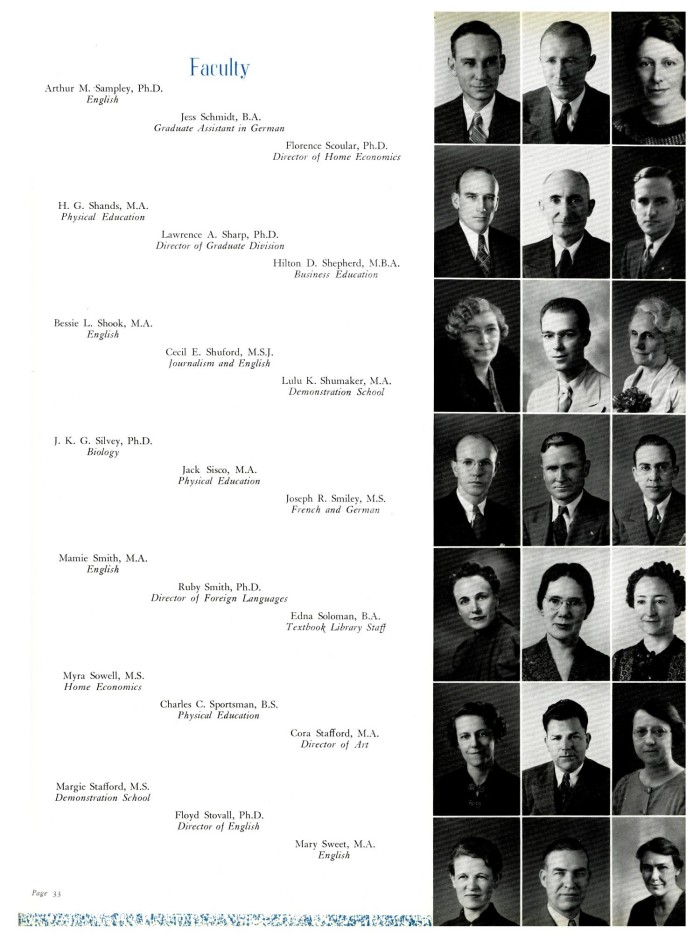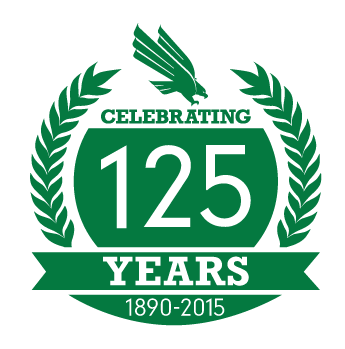One of the most celebrated coaches of UNT history was the aptly named Charles C. Sportsman (Choc). Born in 1902 in McKinney, Texas, he attended Texas University in the fall of 1922 before transferring to North Texas State Normal College (now known as the University of North Texas) in the summer of that same year. He quickly became active on campus, both in athletics and in a variety of organizations. He was the captain of the 1925 varsity football team, earning a letter for athletic accomplishments. He also lettered in track and field and was a member of the Lee Literary Society, president of the Athletic Council, vice-president of his senior class and president of the Collin County Club. He participated in three senior assemblies by performing vocal solos. In 1926, he joined with other campus athletes to organize the T-Club. The club was for athletes who had earned a letter and wanted to promote school spirit. The group elected him the vice-president and the first yell-leader for this organization. The other office holders were Bill Meyers, president; W. B. Hargrave, reporter, and Fay Vernaell, secretary-treasurer. He retired as the captain of the football team in 1926. He gave a speech at the season end banquet where he thanked the team and the coaches for their hard work in the past season.
1926 also saw Sportsman wed Jennie Tunnel, an alumna of the renamed North Texas State Teachers College. The couple planned to live in Choc Sportsman’s hometown of McKinney, Texas.
In 1928, Sportsman became an assistant football coach under the direction of Coach Jack Sisco. By 1930, Sportsman was the coach of track and field. He continued to seek to improve and gain higher academic credentials. Sportsman travelled to Southern California to work on his master’s degree during the summer of that year.
During the 1930’s Sportsman’s track team won nine of eleven Lone Star Conference Championships and held ten Lone Star track records. They held the conference record in every running event except hurdles. He coached “The Flying Twins,” two sets of identical twin brothers (Wayne and Blaine Rideout and Delmer and Elmer Brown). The twins set the world indoor record in the medley relay. They would go on to set other world records as individual set of twins (outdoor distance medley relay) or as a single athlete (the world record in the three-quarter mile run).
The track team competed and trained at Eagle Stadium, the first athletic field at UNT. It was located on today’s Library mall. Originally, the fans stood and watched the competition. By 1929, stands were added to the west side of the field. The track was redesigned in 1930. Field stands were added to the west side in 1933. The east side received stands in 1937. This stadium was dismantled in 1952, when Fouts Field was opened.
In the 1930’s the school held an inter-class track meet that was open to male students. Members of the Varsity Track team acted as coaches for the participants, who were divided into class teams. A good showing could help a man qualify for a place on the Varsity Team. Women were not included in varsity sports until Title IX was signed into law in 1972.
By 1942, World War II had started to drain campus of its male students and faculty. Among those who left to serve their country was Choc Sportsman, who joined the U. S. Navy. He was commissioned a lieutenant in the Navy and assigned to a training program in Annapolis, Virginia. He became the director of the track program at the Navy Pre-Flight School in Georgia.
Lieutenant Commander Charles Sportsman was honorably discharged from the Navy in 1945. North Texas wanted him to return to being a successful coach for the NT track team. Instead, Sportsman decided to return to California to continue his education at the University of Southern California. He would go on to work for San Diego State University for 21 years.
After the war, Sportsman would serve as a State Department athletic consultant at the Theater Athletic Staff School in Stuttgart, Germany. He also coached at other schools, such as the University of Virginia and St. Mary’s College. The State Department also sent Sportsman to Southeast Asia where he worked with the coaches in the Federation of Malaya to set up an athletic program. He commented that, “people are alike all over the world where sports are concerned, regardless of color or nationality.” [Campus Chat, 1959-08-07] He would also coach the 1968 Greek Olympic track squad.
In 1976, he was honored during the Homecoming celebrations with other Golden Eagles: architect O’Neil Ford and Dorothy Babbs (founder of “Old Maid’s Day”). He was inducted into the UNT Athletic Hall of Fame in 1981. The other inductees were Coach Odus Mitchell, “Mean” Joe Greene, Ray Renfro, Johnny Stovall, Don January, Wayne Rideout, and Ted Wright.
In 1987, he attended a reunion of the NT track and Field Hall of Fame members during that year’s Homecoming. All those who had participated in track and field were invited to return to UNT for the celebration. The plan was to fully endow two scholarships: the Pop Noah Scholarship and the Choc Sportsman Scholarship.
After retiring in 1968, Sportsman moved to a cattle ranch near Tyler, Texas. He died in 1994.
Sportsman was posthumously inducted into National Association of Intercollegiate Athletics as Track and Field coach for San Diego State University in 2013
The Sportsman family’s connection to UNT was continued when Choc Sportsman’s nephew was hired by UNT In 1992. Ken Garland was selected as the track and cross-country coach, the same position once held by his uncle. Garland had followed a similar path as his uncle: he was a member of the McKinney High School track team (1961-1964) and a member of the UNT team (1965-1969).










Leave a Reply